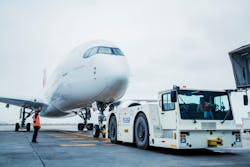The Significance of Developing Safety Culture
In parallel with safety management system (SMS) implementation, safety culture has developed over the years in aircraft ground handling thanks to multiple useful initiatives that have been launched in this regard, including in the Central and South America region.
Claudia Ruiz-Gonzalez, head of safety at Servicios Aeroportuarios Andinos (SAASA), affirms that with regard to safety culture development, initially SAASA developed a diagnosis of the organization, with the participation of employees and the stakeholders, such as airlines, suppliers, as well as the airports and the authorities.
“This allowed us to identify the habits and practices in order to be able to determine our common values and practices,” she says. “Also, the diagnosis results were analyzed by senior management, with the aim of proposing strategies in order to address progressively those relevant issues that affect safety and to establish the guidelines to be followed throughout the organization.
“Reinforcing the reporting culture and the identification of hazards as preventive measures to protect aircraft and people also helped us develop our safety culture.”
Other useful initiatives that also contributed positively at SAASA included establishing a safety and quality assurance program and implementing a “just culture” and “open door policy,” Ruiz-Gonzalez explains.
“The safety and quality assurance program is the same that allowed us to improve the processes through audits. One of the most important audits is that of IATA Safety Audit for Ground Operations (ISAGO) allowing us to carry out a comprehensive review of the entire organization to guarantee safe operations on the ground with aircraft,” she says. “A ‘just culture’ and ‘open door policy’ allows employees to express their concerns and suggestions, turning them into opportunities for improvement, helping us to reduce risks in aircraft ground operations.”
Staff Shortage and Employee Turnover
Safety culture carries significant importance when there is staff shortage and increased employee turnover, which are both typical of aircraft ground handling.
“Of course, safety culture in SAASA is a very important pillar to reduce the likelihood of accidents or incidents, and it strengthens our operations,” says Ruiz-Gonzalez. “When there is a shortage of staff or an increased turnover of staff, the risks will increase, since the entry of new staff demands a period of time for their adaptation to the safety culture of the organization (learning process), as well as the evaluation of new staff in order to measure compatibility to the safety culture.”
The shortage of personnel in the highly regulated aeronautical sector is an exogenous factor that organizations must consider, since the process of adapting the new staff from other industries and cultures implies a greater challenge and measures the strength of the safety culture, explains Ruiz-Gonzalez.
“Finally, employee turnover needs to be analysed in deeply in order to determine its causes and to avoid the high costs that such turnover entails,” she says.
Mitigating Risk
In aircraft ground handling, the safety culture concept has emerged as a defense mechanism for airlines to mitigate risks when interacting with ground support services, through the requirements of standard operating procedures (SOPs), the aviation regulations of a specific state and subsequently through periodic audits, that ended in the need to implement an operational safety management system as it is in the airlines, according to Ruiz-Gonzalez.
“Organizations such as IATA have proposed programs such as ISAGO and IOSA (IATA Operational Safety Audit), where procedures and their impact on safety are evaluated from a comprehensive perspective, achieving high and safe standards in ground support operations and in SAASA we are aligned to these safety standards,” she says.
“The risks in aviation are dynamic, therefore there are always opportunities for continuous improvement,” Ruiz-Gonzalez continues. “Safety culture is still evolving and adapting according to industry trends.”
About the Author

Mario Pierobon
Dr. Mario Pierobon provides solutions in the areas of documentation, training and consulting to organizations operating in safety-sensitive industries. He has conducted a doctoral research project investigating aircraft ground handling safety. He may be reached at [email protected].
